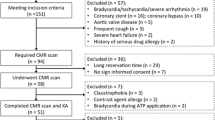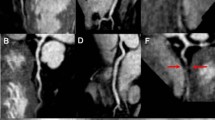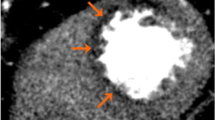Abstract
Background
Noninvasive diagnosis of coronary artery disease (CAD) in women is crucial because of a lower prevalence of CAD in premenopausal women, different cardiac risk profile and pattern of CAD, lower exercise tolerance and more atypical symptoms compared to men. Therefore, we tested the diagnostic power of cardiac magnetic resonance first pass perfusion imaging (CMR-FPPI) for the diagnosis of significant coronary stenoses in females versus males.
Methods and results
256 consecutive patients, 77 females and 179 males with atypical or typical chest pain and intermediate risk of CAD were studied by coronary angiography and CMR-FPPI (1.5T Intera CV). A three-slice, short-axis perfusion scan with a saturation prepulse was performed during infusion of adenosine and at rest followed by late enhancement imaging for myocardial scar. Gadolinium-DTPA was administered at 0.1 mmol/kg body weight. Perfusion images were visually analysed, coronary stenoses by quantitative coronary angiography. Sensitivity, specificity and accuracy of CMR-FPPI for detection of a significant coronary artery stenosis (≥50% luminal narrowing) in the entire group were 91.3, 81.7 and 88.6%, the corresponding values for females were 90.9, 90.6 and 90.8% and for males 91.4, 74.4 and 87.7%, and in the subgroup of females with suspected primary CAD 83.3, 96.0 and 93.6%, and for suspected progression 92.1, 71.4 and 88.9%.
Conclusion
Diagnostic accuracy of CMR-FPPI is very high in women with intermediate risk of CAD and comparable or in part superior to results in males. With the advantage of the absence of radiation exposure and high spatial and temporal resolution, CMR-FPPI has the potential to become the preferred imaging test to select women for coronary angiography.


Similar content being viewed by others
References
Lerner DJ, Kannell WB (1986) Patterns of coronary heart disease morbidity and mortality in the sexes: a 26-year follow-up of the Framingham population. Am Heart J 111:383–390
Gibbons RJ, Balady GJ, Bricker JT, Chaitman BR, Fletcher GF, Froehlicher VF, Mark DB, McCallister BD, Mooss AN, O’Reilly MG, Winters WL Jr, Gibbons RJ, Antman EM, Alpert JS, Faxon DP, Fuster V, Gregoratos G, Hiratzka LF, Jacobs AK, Russell RO, Smith AC Jr, ACC/AHA Task Force on Practice Guidelines (Committee to Update the 1997 Exercise Testing Guidelines) (2002) ACC/AHA 2002 guideline update for exercise testing: summary article: a report of the American College of Cardiology/American Heart Association Task Force on Practice Guidelines (Committee to Update the 1997 Exercise testing Guidelines). Circulation 106:1883–1892
Kwok Y, Kim C, Grady D, Segal M, Redberg R (1999) Meta-analysis of exercise testing to detect coronary artery disease in women. Am J Cardiol 83:660–666
Mieres JH, Shaw LJ, Arai A, Budoff MJ, Flamm SD, Hundley WG, Marwick TH, Mosca L, Patel AR, Quinones MA, Redberg RF, Taubert KA, Taylor AJ, Thomas GS, Wenger NK (2005) Role of non-invasive testing in the clinical evaluation of women with suspected coronary artery disease: consensus statement from the Cardiac imaging Committee, Council on Clinical Cardiology, and the Cardiovascular Imaging and Intervention Committee, Council on Cardiovascular Radiology and Intervention, American Heart Association. Circulation 111:682–696
Kim C, Kwok YS, Heagerty P, Redberg R (2001) Pharmacologic stress testing for coronary artery disease: a meta-analysis. Am Heart J 142:934–944
Taillefer R, DePuey EG, Udelson JE, Beller GA, Latour Y, Reeves F (1997) Comparative diagnostic accuracy of Tl-201 and Tc-99m sestamibi SPECT imaging (perfusion and ECG-gated SPECT) in detecting coronary artery disease in women. J Am Coll Cardiol 29:69–77
Santana-Boado C, Candell-Riera J, Castell-Conesa J, Aguade-Bruix S, Garcia-Burillo A, Canela T, Gonzalez JM, Cortadellas J, Ortega D, Soler-Soler J (1998) Diagnostic accuracy of technetium-99m-MIBI myocardial SPECT in women and men. J Nucl Med 39:751–755
Merkle N, Wöhrle J, Grebe O, Nusser T, Kunze M, Kestler HA, Kochs M, Hombach V (2007) Assessment of myocardial perfusion for detection of coronary artery stenoses by steady state, free-precession magnetic resonance first-pass imaging. Heart 93:1381–1385
Doesch C, Seeger A, Hoevelborn T, Klumpp B, Fenchel M, Kramer U, Schönfisch B, Claussen CD, Gawaz M, Miller S, May AE (2008) Adenosine stress cardiac magnetic resonance imaging for the assessment of ischemic heart disease. Clin Res Cardiol 97:905–912
Pilz G, Bernhardt P, Klos M, Ali E, Wild M, Höfling B (2006) Clinical implication of adenosine-stress cardiac magnetic resonance imaging as potential gatekeeper prior to invasive examination in patients with AHA/ACC class II indication for coronary angiography. Clin Res Cardiol 95:531–538
Hombach V, Merkle N, Kestler HA, Torzewski J, Kochs M, Marx N, Nusser T, Burgstahler C, Rasche V, Bernhardt P, Kunze M, Wöhrle J (2008) Characterization of patients with acute chest pain using cardiac magnetic resonance imaging. Clin Res Cardiol 97:760–767
Wöhrle J, Kochs M, Spiess J, Nusser T, Hombach V, Merkle N (2009) Impact of percutaneous device implantation for closure of patent foramen ovale on valve insufficiencies. Circulation 119:3002–3008
Pruessmann KP, Weiger M, Scheidegger MB, Boesiger P (1999) SENSE: sensitivity encoding for fast MRI. Magn Reson Med 42:952–962
Look DC, Locker DR (1970) Time saving measurement of NMR and EPR relaxation times. Rev Sci Instrum 41:250–251
Rinker A, Nusser T, Grossmann G, Koenig W, Wöhrle J (2009) Angiographic results of a Tacrolimus-eluting stent in acute coronary syndrome lesions. Clin Res Cardiol 98:89–93
Herdeg C, Göhring-Frischholz K, Haase KK, Geisler T, Zürn C, Hartmann U, Wöhrle J, Nusser T, Dippon J, May AE, Gawaz M (2009) Catheter-based delivery of fluid paclitaxel for prevention of restenosis in native coronary artery lesions after stent implantation. Circ Cardiovasc Interv. DOI:10.1161/CIRCINTERVENTIONS.108.827865
Douglas P, Ginsburg GS (1996) The evaluation of chest pain in women. New Engl J Med 334:1311–1315
Hundley WG, Morgan TM, Neagle CM, Hamilton CA, Rerkpattanapiat P, Link KM (2002) Magnetic resonance imaging determination of cardiac prognosis. Circulation 106:2328–2333
Nagel E, Lehmkuhl HB, Klein C, Schneider U, Frantz E, Ellmer A, Boksch W, Dreysse S, Fleck E (1999) Influence of image quality on the diagnostic accuracy of dobutamine stress magnetic resonance imaging in comparison with dobutamine stress echocardiography for the noninvasive detection of myocardial ischemia. Z Kardiol 88:622–630
Jahnke C, Nagel E, Gebker R, Kokocinski T, Kelle S, Manka R, Fleck E, Paetsch I (2007) Prognostic value of cardiac magnetic resonance stress tests: adenosine stress perfusion and dobutamine stress wall motion imaging. Circulation 115:1769–1776
Hombach V, Grebe O, Merkle N, Waldenmaier S, Höher M, Kochs M, Wöhrle J, Kestler HA (2005) Sequelae of acute myocardial infarction regarding cardiac structure and function and their prognostic significance as assessed by magnetic resonance imaging. Eur Heart J 26:549–557
Ibrahim T, Nekolla SG, Schreiebr K, Odaka K, Volz S, Mehilli J, Guthlin M, Delis W, Schwaiger M (2002) Assessment of coronary flow reserve: comparison between contrast-enhanced magnetic resonance imaging and positron emission tomography. J Am Coll Cardiol 39:864–870
Buchthal SD, den Hollander JA, Merz CN, Rogers WJ, Pepine CJ, Reichek N, Sharaf BL, Reis S, Kelsey SF, Pohost GM (2000) Abnormal myocardial phosphorus-31 nuclear magnetic resonance spectroscopy in women with chest pain but normal coronary angiograms. N Engl J Med 342:829–835
Johnson BD, Shaw LJ, Buchtal S, Bairey-Merz CN, Kim H-W, den Hollander J, Scott K, Olson M, Pepine CJ, Rogers W, Mankad S, Doyle M, Forder J, Pohost GM, National Institutes of Health–National Heart, Lung, and Blood Institute (2004) Prognosis in women with myocardial ischemia in the absence of obstructive coronary disease: results from the National Institutes of Health–National Heart, Lung, and Blood Institute–Sponsored Women’s Ischemia Syndrome Evaluation (WISE). Circulation 109:2993–2999
Panting JR, Gatehouse PD, Young GZ, Grothues F, Firmin DN, Collins P, Pennell DJ (2002) Abnormal subendocardial perfusion in cardiac syndrome X detected by cardiovascular magnetic resonance imaging. N Engl J Med 346:1948–1953
Acknowledgments
This study was supported in part by an unrestricted grant of Philips Medical Systems Best, The Netherlands, and Hamburg, Germany.
Conflict of interest statement
None.
Author information
Authors and Affiliations
Corresponding author
Additional information
N. Merkle and J. Wöhrle contributed equally to this work. Both are first authors.
Rights and permissions
About this article
Cite this article
Merkle, N., Wöhrle, J., Nusser, T. et al. Diagnostic performance of magnetic resonance first pass perfusion imaging is equally potent in female compared to male patients with coronary artery disease. Clin Res Cardiol 99, 21–28 (2010). https://doi.org/10.1007/s00392-009-0071-8
Received:
Accepted:
Published:
Issue Date:
DOI: https://doi.org/10.1007/s00392-009-0071-8




